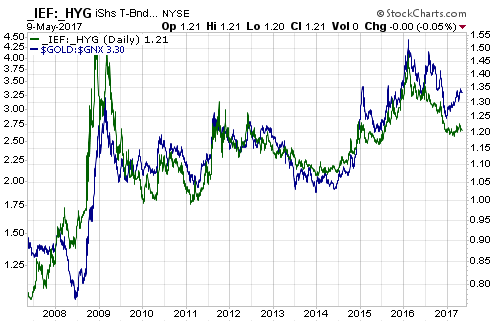To believe that the gold market is influenced by the manipulation of a banking cartel to the extent that the gold price doesn’t reflect the true fundamental drivers it is necessary to have almost no understanding of what those price drivers are and how they should affect the market. There are many fundamental relationships between gold and other markets that I could show in chart form to support this statement, but in this post I’ll focus on a chart that illustrates the relationship between gold, commodities and economic confidence.
The change in the average credit spread, that is, the change in the average difference between yields on relatively high-risk and relatively low-risk bonds, is a good indicator of changes in economic confidence. Specifically, when credit spreads are widening it means that confidence is on the decline and when credit spreads are narrowing it means that confidence is on the rise.
Fortunately, there are a number of easy and accurate ways of determining whether credit spreads are widening or narrowing. One that I like to use is the IEF/HYG ratio. This ratio is the price of an ETF that holds 7-10 year Treasury securities divided by the price of an ETF that holds junk bonds of similar duration. A rising IEF/HYG ratio indicates widening credit spreads (falling economic confidence) and a falling IEF/HYG ratio indicates narrowing credit spreads (rising economic confidence).
Those who understand gold’s role in the financial world would know that the gold price should generally trend upward relative to the prices of most other commodities (as represented by a broad-based commodity index such as GNX) when economic confidence is on the decline and trend downward relative to the prices of most other commodities when economic confidence is on the rise. Absent manipulative forces that prevent gold from behaving in the proper way, what we should therefore see is a positive correlation between the gold/commodity ratio and the IEF/HYG ratio. This is exactly what we do see in the following chart.
All markets are, always have been and always will be manipulated, but this generally doesn’t prevent them from responding in a reasonable way to the genuine fundamentals over multi-month periods.
 Print This Post
Print This Post

